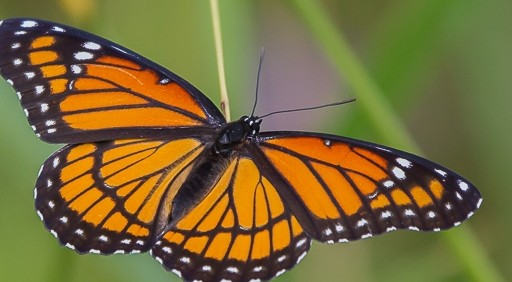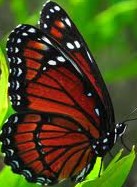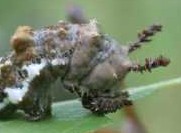 The viceroy can be found through out most of the US, southern Canada and northern Mexico where it inhabits moist open or shrubby areas such as land around lakes, along streams, swamp edges, marshes, and wet meadows. The wings are 2.5-3.4 inches across and are orange with black veins and white spots along the edges. Viceroys resemble monarch butterflies but are smaller and have a black line curving across the veins of the hind wings.
The viceroy can be found through out most of the US, southern Canada and northern Mexico where it inhabits moist open or shrubby areas such as land around lakes, along streams, swamp edges, marshes, and wet meadows. The wings are 2.5-3.4 inches across and are orange with black veins and white spots along the edges. Viceroys resemble monarch butterflies but are smaller and have a black line curving across the veins of the hind wings.
 Male viceroys typically patrol for females from late morning with mating occurring in the afternoon. The females lays two to three oval eggs on the at a time on the tips of the host plant’s leaves before moving on to another plant and more egg laying. The caterpillars are 1-1.25 inches long, mottled green or brown and have a saddle shaped patch on their back. Their foreparts are humped and two bristles emerge from behind the head. They eat their egg shells and then feed on the leaves and flowers of the host plant. The chrysalis is about 7/8 inches long and is cream colored with brown markings. There are usually two to three generations between spring and mid-summer each year in most of the US.
Male viceroys typically patrol for females from late morning with mating occurring in the afternoon. The females lays two to three oval eggs on the at a time on the tips of the host plant’s leaves before moving on to another plant and more egg laying. The caterpillars are 1-1.25 inches long, mottled green or brown and have a saddle shaped patch on their back. Their foreparts are humped and two bristles emerge from behind the head. They eat their egg shells and then feed on the leaves and flowers of the host plant. The chrysalis is about 7/8 inches long and is cream colored with brown markings. There are usually two to three generations between spring and mid-summer each year in most of the US.
 Viceroys depend primarily on mimicry for protection against their avarian predators. The adults exhibit Mullerian mimicry with monarchs, both being bad tasting. The eggs resemble the insect galls found on the host plants and the caterpillers and chrysalis stage resemble bird droppings.
Viceroys depend primarily on mimicry for protection against their avarian predators. The adults exhibit Mullerian mimicry with monarchs, both being bad tasting. The eggs resemble the insect galls found on the host plants and the caterpillers and chrysalis stage resemble bird droppings.
To encourage a viceroy population in your garden you need a moist area to grow host plants. The caterpillars like members of the willow family (Salicaceae) including willow (Salix spp.), cottonwood, poplar, and aspen (Populus spp). The adults feed on a variety of flowers, primarily in the aster family (Asteracea) but when flowers are scarce as in early spring will feed on manure, rotton fruit, and carrion. Garden plants favored by adults include goldenrod (Solidago spp.), milkweed (Asclepias), and asters (Aster sp.) Thistles are also liked but some are considered serious weeds and at best belong in a wildflower gardener abandon field. .